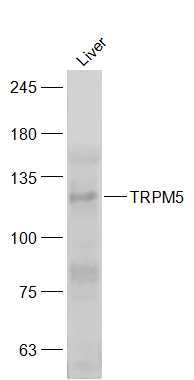
Rabbit Anti-TRPM5 antibody
MLSN1 and TRP related gene 1; MLSN1 and TRP related gene 1 protein; MLSN1 and TRP-related; MLSN1- and TRP-related gene 1 protein; MTR1; Novel protein similar to vertebrate transient receptor potential cation channel, subfamily M, member 5 ; Transient rece
View History [Clear]
Details
Product Name TRPM5 Chinese Name 瞬时受体电位离子Channel protein5抗体(M亚家族) Alias MLSN1 and TRP related gene 1; MLSN1 and TRP related gene 1 protein; MLSN1 and TRP-related; MLSN1- and TRP-related gene 1 protein; MTR1; Novel protein similar to vertebrate transient receptor potential cation channel, subfamily M, member 5 ; Transient receptor potential cation channel subfamily M member 5; Transient receptor potential cation channel, subfamily M, member 5; Trpm5; TRPM5 transient receptor potential cation channel, subfamily M, member 5; TRPM5_HUMAN; 9430099A16Rik; Long transient receptor potential channel 5; LTrpC-5; LTrpC5. Research Area Cell biology immunology Neurobiology Immunogen Species Rabbit Clonality Polyclonal React Species Human, Mouse, (predicted: Rat, Cow, ) Applications WB=1:500-2000 ELISA=1:5000-10000
not yet tested in other applications.
optimal dilutions/concentrations should be determined by the end user.Theoretical molecular weight 131kDa Cellular localization The cell membrane Form Liquid Concentration 1mg/ml immunogen KLH conjugated synthetic peptide derived from human TRPM5: 701-800/1165 <Extracellular> Lsotype IgG Purification affinity purified by Protein A Buffer Solution 0.01M TBS(pH7.4) with 1% BSA, 0.03% Proclin300 and 50% Glycerol. Storage Shipped at 4℃. Store at -20 °C for one year. Avoid repeated freeze/thaw cycles. Attention This product as supplied is intended for research use only, not for use in human, therapeutic or diagnostic applications. PubMed PubMed Product Detail Voltage-modulated Ca(2+)-activated, monovalent cation channel (VCAM) that mediates a transient membrane depolarization and plays a central role in taste transduction. Monovalent-specific, non-selective cation channel that mediates the transport of Na(+), K(+) and Cs(+) ions equally well. Activated directly by increases in intracellular Ca(2+), but is impermeable to it. Gating is voltage-dependent and displays rapid activation and deactivation kinetics upon channel stimulation even during sustained elevations in Ca(2+). Also activated by a fast intracellular Ca(2+) increase in response to inositol 1,4,5-triphosphate-producing receptor agonists. The channel is blocked by extracellular acidification. External acidification has 2 effects, a fast reversible block of the current and a slower irreversible enhancement of current inactivation. Is a highly temperature-sensitive, heat activated channel showing a steep increase of inward currents at temperatures between 15 and 35 degrees Celsius. Heat activation is due to a shift of the voltage-dependent activation curve to negative potentials. Activated by arachidonic acid in vitro. May be involved in perception of bitter, sweet and umami tastes. May also be involved in sensing semiochemicals.
Function:
Voltage-modulated Ca(2+)-activated, monovalent cation channel (VCAM) that mediates a transient membrane depolarization and plays a central role in taste transduction. Monovalent-specific, non-selective cation channel that mediates the transport of Na(+), K(+) and Cs(+) ions equally well. Activated directly by increases in intracellular Ca(2+), but is impermeable to it. Gating is voltage-dependent and displays rapid activation and deactivation kinetics upon channel stimulation even during sustained elevations in Ca(2+). Also activated by a fast intracellular Ca(2+) increase in response to inositol 1,4,5-triphosphate-producing receptor agonists. The channel is blocked by extracellular acidification. External acidification has 2 effects, a fast reversible block of the current and a slower irreversible enhancement of current inactivation. Is a highly temperature-sensitive, heat activated channel showing a steep increase of inward currents at temperatures between 15 and 35 degrees Celsius. Heat activation is due to a shift of the voltage-dependent activation curve to negative potentials. Activated by arachidonic acid in vitro. May be involved in perception of bitter, sweet and umami tastes. May also be involved in sensing semiochemicals.
Subcellular Location:
Cell membrane
Tissue Specificity:
Strongly expressed in fetal brain, liver and kidney, and in adult prostate, testis, ovary, colon and peripheral blood leukocytes. Also expressed in a large proportion of Wilms' tumors and rhabdomyosarcomas. In monochromosomal cell lines shows exclusive paternal expression.
Similarity:
Belongs to the transient receptor (TC 1.A.4) family. LTrpC subfamily. TRPM5 sub-subfamily.
SWISS:
Q9NZQ8
Gene ID:
29850
Database links:Entrez Gene: 29850 Human
Entrez Gene: 56843 Mouse
Omim: 604600 Human
SwissProt: Q9NZQ8 Human
SwissProt: Q9JJH7 Mouse
Unigene: 272287 Human
Unigene: 286668 Mouse
Product Picture
References (0)
No References
Bought notes(bought amounts latest0)
No one bought this product
User Comment(Total0User Comment Num)
- No comment



 +86 571 56623320
+86 571 56623320
 +86 18668110335
+86 18668110335

